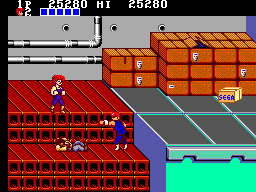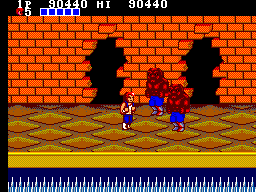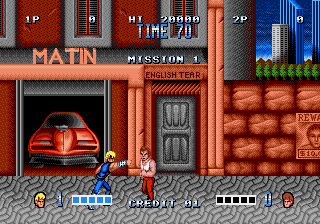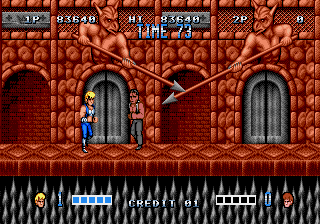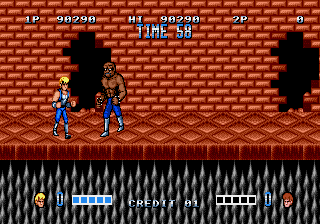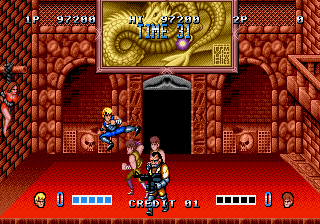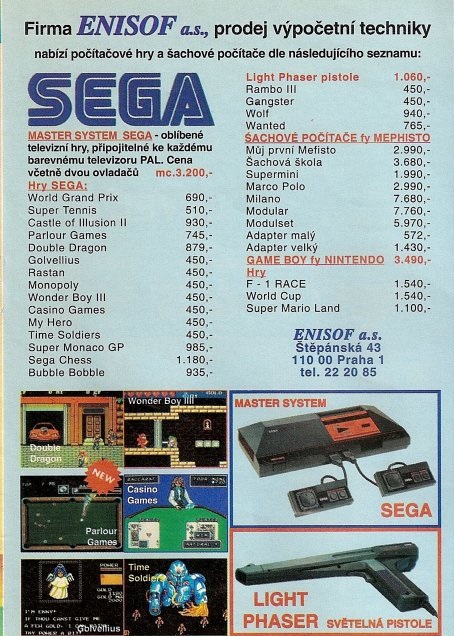Difference between revisions of "Double Dragon"
From Sega Retro
Hyperspeed34 (talk | contribs) |
|||
| Line 5: | Line 5: | ||
| tab1=Mega Drive | | tab1=Mega Drive | ||
| tab2=Master System | | tab2=Master System | ||
| − | | publisher={{company|[[Sega]]|system=SMS}} | + | | publisher={{company|[[Sega Enterprises, Ltd.]]|system=SMS|region=JP, EU}} {{company|[[Sega of America]]|system=SMS|region=US}} {{company|[[Ballistic]]|system=MD}} |
| − | {{company|[[Ballistic]]|system=MD}} | ||
| developer={{company|[[Arc System Works]]{{ref|https://web.archive.org/web/20151009104108/http://www.famitsu.com/news/201510/09086051.html}}|system=SMS}} | | developer={{company|[[Arc System Works]]{{ref|https://web.archive.org/web/20151009104108/http://www.famitsu.com/news/201510/09086051.html}}|system=SMS}} | ||
{{company|[[Accolade]]|system=MD}} | {{company|[[Accolade]]|system=MD}} | ||
| Line 53: | Line 52: | ||
| otherformats={{NonSega|Arcade|Amiga|CPC|2600|7800|ST|C64|IBMPC|GB|GBA|LYNX|MSX|NES|Spectrum}} | | otherformats={{NonSega|Arcade|Amiga|CPC|2600|7800|ST|C64|IBMPC|GB|GBA|LYNX|MSX|NES|Spectrum}} | ||
}} | }} | ||
| − | '''''{{PAGENAME}}''''' (ダブルドラゴン) is a beat-'em-up by [[Technos]] released for the arcades in 1987. It is considered a spiritual sequel to Technos's previous hit ''[[Renegade]]''. The original arcade game was a blockbuster success and established a number of conventions that would define the beat-'em-up genre, serving as a precursor to later games in the genre such as ''[[Final Fight]]'' and ''[[Streets of Rage]]''. The game was ported to several consoles and home computers since its original arcade release, including to | + | '''''{{PAGENAME}}''''' (ダブルドラゴン) is a beat-'em-up by [[Technos]] released for the arcades in 1987. It is considered a spiritual sequel to Technos's previous hit ''[[Renegade]]''. The original arcade game was a blockbuster success and established a number of conventions that would define the beat-'em-up genre, serving as a precursor to later games in the genre such as ''[[Final Fight]]'' and ''[[Streets of Rage]]''. The game was ported to several consoles and home computers since its original arcade release, including to Sega consoles twice: the first time was for the [[Sega Master System|Master System]] by Sega themselves in 1988, and later for the [[Sega Mega Drive|Genesis]] in 1992 by [[Accolade]]. |
==Story== | ==Story== | ||
Revision as of 04:01, 20 November 2024
- For the Sega Game Gear game, see Double Dragon (Game Gear).
| ||||||||||||||||||||||||||||||||||||||||||||||||||||||||||||||||||||||
| Double Dragon | ||||||||||||||||||||||||||||||||||||||||||||||||||||||||||||||||||||||
|---|---|---|---|---|---|---|---|---|---|---|---|---|---|---|---|---|---|---|---|---|---|---|---|---|---|---|---|---|---|---|---|---|---|---|---|---|---|---|---|---|---|---|---|---|---|---|---|---|---|---|---|---|---|---|---|---|---|---|---|---|---|---|---|---|---|---|---|---|---|---|
| System(s): Sega Master System, Sega Mega Drive | ||||||||||||||||||||||||||||||||||||||||||||||||||||||||||||||||||||||
| Publisher: Sega Enterprises, Ltd. (JP, EU) Sega of America (US) Ballistic | ||||||||||||||||||||||||||||||||||||||||||||||||||||||||||||||||||||||
| Developer: Arc System Works[1] Accolade | ||||||||||||||||||||||||||||||||||||||||||||||||||||||||||||||||||||||
| Distributor: Tonka (US, later printings) Ecofilmes (PT) Tec Toy (BR) Samsung (KR) | ||||||||||||||||||||||||||||||||||||||||||||||||||||||||||||||||||||||
| Licensor: Technos Japan, Tradewest | ||||||||||||||||||||||||||||||||||||||||||||||||||||||||||||||||||||||
| Original system(s): Arcade boards | ||||||||||||||||||||||||||||||||||||||||||||||||||||||||||||||||||||||
| Developer(s) of original games: Technos | ||||||||||||||||||||||||||||||||||||||||||||||||||||||||||||||||||||||
| Sound driver: Sound Images v1.0 | ||||||||||||||||||||||||||||||||||||||||||||||||||||||||||||||||||||||
| Peripherals supported: FM Sound Unit | ||||||||||||||||||||||||||||||||||||||||||||||||||||||||||||||||||||||
| Genre: Action[2], Arcade[3] | ||||||||||||||||||||||||||||||||||||||||||||||||||||||||||||||||||||||
| Number of players: 1-2 | ||||||||||||||||||||||||||||||||||||||||||||||||||||||||||||||||||||||
| ||||||||||||||||||||||||||||||||||||||||||||||||||||||||||||||||||||||
|
Double Dragon (ダブルドラゴン) is a beat-'em-up by Technos released for the arcades in 1987. It is considered a spiritual sequel to Technos's previous hit Renegade. The original arcade game was a blockbuster success and established a number of conventions that would define the beat-'em-up genre, serving as a precursor to later games in the genre such as Final Fight and Streets of Rage. The game was ported to several consoles and home computers since its original arcade release, including to Sega consoles twice: the first time was for the Master System by Sega themselves in 1988, and later for the Genesis in 1992 by Accolade.
Contents
Story
Near the end of the 20th century, violence ruled the streets of New York City after the nuclear war and people began forming gangs to survive. On the outskirts of the city lived twin brothers named Jimmy and Billy Lee. The brothers used to run a martial arts school in the centre of the city which was burned down to ashes five years ago as a result of the nuclear war. Despite this, the brothers did not neglect their training for even a day.
The younger brother, Billy, was romantically involved with a female instructor named Marian, but Jimmy was secretly in love with her as well. One day, Marian was abducted by the Black Warriors, a savage street gang led by a man named Willy Mackey. The gang gradually grew in size after the nuclear war and they are now dominant organization of the city.
The Lee brothers set out to confront the Black Warriors and rescue Marian.
Gameplay
Master System version
Double Dragon is a belt-scrolling beat-'em-up, meaning that the ground is depicted from a titled perspective that allows movement sideways as well as vertically (in and out of the plane). The game can be played by up to two players simultaneously, with the first player controlling Billy Lee (who wears a blue outfit) and the second player controlling his twin brother Jimmy (in red). The objective of the game is to defeat every enemy from one area to the next until reaching the end of the stage and defeating a boss. The second player can join the game at any point (except during the last stage) by pressing ![]() on the control pad.
on the control pad.
The brothers can move in any direction using the D-Pad. They punch with ![]() and kick with
and kick with ![]() . Using the same attack repeatedly performs a combo that ends by knocking the opponent down. They can do an elbow smash that hits enemies behind them by holding the D-Pad in the opposite direction that they are facing while pressing
. Using the same attack repeatedly performs a combo that ends by knocking the opponent down. They can do an elbow smash that hits enemies behind them by holding the D-Pad in the opposite direction that they are facing while pressing ![]() . They can headbutt opponents with
. They can headbutt opponents with ![]()
![]() or
or ![]()
![]() . They can grab downed opponents and knee smash them with
. They can grab downed opponents and knee smash them with ![]() or throw them with
or throw them with ![]() . The characters can perform a flying jump kick by pressing
. The characters can perform a flying jump kick by pressing ![]() +
+![]() while moving with the D-Pad. Or they can perform a leaping reverse kick (a jumping kick in the opposite direction that they are facing) by pressing
while moving with the D-Pad. Or they can perform a leaping reverse kick (a jumping kick in the opposite direction that they are facing) by pressing ![]() +
+![]() when standing in place. These jump kicks are sometimes necessary to jump onto platforms in some stages.
when standing in place. These jump kicks are sometimes necessary to jump onto platforms in some stages.
In addition to their hand-to-hand techniques, the brothers can equip numerous weapons, which are found on the ground or dropped by enemies when they are knocked down. Weapons can be picked up with ![]() when standing over them and used with
when standing over them and used with ![]() (replacing the punch). Weapons include whips and bats, which are swung at opponents and give the characters increased reach, and knives and dynamite, which are thrown at enemies. The characters can also pick up and throw large objects such as drums or rocks.
(replacing the punch). Weapons include whips and bats, which are swung at opponents and give the characters increased reach, and knives and dynamite, which are thrown at enemies. The characters can also pick up and throw large objects such as drums or rocks.
The brothers have health meters consisting of five segments and lose a segment whenever they take damage from an opponent. They lose a life if they take damage without any health remaining but revive in place after a moment if the player has extra lives remaining. There are also some basic platforming sections in which characters can lose a life if they fall off the stage. Each player starts the game with three lives, and players also start the final stage with three lives regardless of how many they had before. Players earn an extra life for every 30,000 points collected. The game ends if the player runs out of lives. The player has a limited amount of time to press ![]() to continue the game (resetting the score) after running out of lives. The game has unlimited continues, except for the last stage, which cannot be continued.
to continue the game (resetting the score) after running out of lives. The game has unlimited continues, except for the last stage, which cannot be continued.
Stages
| The Slums | |
|---|---|
| Map: 1️⃣ | |
| The Factory District | |
| Map: 1️⃣ | |
| The Park | |
| Map: 1️⃣ | |
| The Black Warriors Headquarters | |
| Map: 1️⃣ | |
Mega Drive version
The game is a belt-scrolling beat-'em-up played as one or both of the Lee brothers. It can be started as a two-player game, or another player can join during gameplay by pressing START .
The brothers move sideways with ![]() and
and ![]() as well as towards or away from the background with
as well as towards or away from the background with ![]() and
and ![]() . They jump with
. They jump with ![]() . Stages sometimes contain platforming sections (such as jumping over gaps). Some stages contain ladders or fences in the background that can be climbed with
. Stages sometimes contain platforming sections (such as jumping over gaps). Some stages contain ladders or fences in the background that can be climbed with ![]() and
and ![]() .
.
The brothers punch with ![]() and kick with
and kick with ![]() . The basic attacks consists of a left-right punch combo and a kick. After a couple of punches or a single kick, the enemy is stunned. During this period, the player can follow it up with an uppercut, a roundhouse kick, or a head grab (depending on the enemy type). During a head grab, the player can repeatedly kick an enemy with their knees with
. The basic attacks consists of a left-right punch combo and a kick. After a couple of punches or a single kick, the enemy is stunned. During this period, the player can follow it up with an uppercut, a roundhouse kick, or a head grab (depending on the enemy type). During a head grab, the player can repeatedly kick an enemy with their knees with ![]() or throw him to the other side with
or throw him to the other side with ![]() . Some enemies can also be grabbed from behind during two-player mode, allowing the other player to attack them. Characters can elbow smash foes behind them with
. Some enemies can also be grabbed from behind during two-player mode, allowing the other player to attack them. Characters can elbow smash foes behind them with ![]() +
+![]() . They can perform a jump kick by jumping with
. They can perform a jump kick by jumping with ![]() and pressing
and pressing ![]() if facing left or
if facing left or ![]() if facing right. They can perform a jump kick by jumping with
if facing right. They can perform a jump kick by jumping with ![]() and pressing
and pressing ![]() if facing left or
if facing left or ![]() if facing right. Or they can perform a leaping reverse kick by jumping with
if facing right. Or they can perform a leaping reverse kick by jumping with ![]() and pressing
and pressing ![]() if facing left or
if facing left or ![]() if facing right. They can headbutt opponents with
if facing right. They can headbutt opponents with ![]()
![]() or
or ![]()
![]() .
.
There are also several types of weapons that are either found on the ground in certain areas or by disarming an armed enemy. Characters can pick up a weapon with ![]() when standing near it and use the weapon with
when standing near it and use the weapon with ![]() (replacing punch). Certain large objects can also be kicked to the ground with
(replacing punch). Certain large objects can also be kicked to the ground with ![]() .
.
The brothers have health meters consisting of five segments and lose a segment whenever they take damage from an opponent. They lose a life if they take damage without any health remaining, fall off the stage, or run out of time but revive in place after a moment if the player has extra lives remaining. The timer starts over if the players get a time over. Players earn an extra life for every 30,000 points collected. The game ends if the player runs out of lives, but it can be continued if the players have credits remaining. Players have separate lives but share credits. The players can decide the number of starting lives and credits (2, 4, or 6) in the options before starting the game.
Stages
| The City Slum | |
|---|---|
| The Industrial Area | |
| The Forest | |
| The Hideout of the Shadow Boss | |
Versions
Master System version
The Master System version is a downscaled adaptation of the arcade game similar to the NES version released before it. While the character designs are pretty similar to the NES version, the Master System version retains the two-player co-op mode and features level designs much closer to the arcade game (albeit without the vertical scrolling and climbable ladders and fences in some areas). Because the arcade version used a three button setup (with a dedicated jump button), the input method of certain moves such as the flying jump kick, backward spin kick and elbow strike were changed to better accommodate the Master System's two button controls. The consecutive attacks (the uppercut and roundhouse kick) and the hair grab are also performed a bit differently. The Master System only displays up to three enemies and a single weapon on-screen at once. Stages are not timed in this version.
Mega Drive version
In contrast, the Mega Drive version is a relatively straight port of the arcade with slight differences in graphics and sound. Most notably the backgrounds graphics are different, some of the character sprites (specifically Marian and Linda) are not 100% accurate, and the head-swapped boss characters (the mohawked version of Abobo at the end of Missions 1 and 3, and the Lee brother lookalike at the end of Mission 2) are replaced with plain palette swaps. While the arcade game presents itself as one continuous stage without interruption, the Mega Drive version, like other ports of the game, blackens the screen between stages.
Localised names
| Language | Localised Name | English Translation |
|---|---|---|
| English | Double Dragon | Double Dragon |
| English (US) | Double Dragon | Double Dragon |
| Japanese | ダブルドラゴン-双截龍 | Double Dragon |
| Portuguese (Brazil) | Double Dragon | |
| Korean | 더블드래곤 | Double Dragon |
Production credits
Master System version
- Programmer: Minoru Kidooka[1]
Mega Drive version
- Design and Programming: Tradewest
- Producer: Chris Bankston
- Testers: Robert Daly, Steve Graziano
- Manual: Jeff Wagner
Magazine articles
- Main article: Double Dragon/Magazine articles.
Promotional material
also published in:
- Mean Machines (UK) #18: "March 1992" (1992-02-27)[12]
also published in:
- Electronic Gaming Monthly (US) #41: "December 1992" (1992-xx-xx)[13]
Physical scans
Master System version
| Sega Retro Average | ||||||||||||||||||||||||||||||||||||||||||||||||||||||||||||||||||||||||||
|---|---|---|---|---|---|---|---|---|---|---|---|---|---|---|---|---|---|---|---|---|---|---|---|---|---|---|---|---|---|---|---|---|---|---|---|---|---|---|---|---|---|---|---|---|---|---|---|---|---|---|---|---|---|---|---|---|---|---|---|---|---|---|---|---|---|---|---|---|---|---|---|---|---|---|
|
| 75 | |
|---|---|
| Based on 14 reviews | |
| Master System, SE |
|---|
|
Mega Drive version
| Sega Retro Average | ||||||||||||||||||||||||||||||||||||||||||||||||||||||||||||||||||||||||||||||||||||||||||||||||||||||||||||||||||
|---|---|---|---|---|---|---|---|---|---|---|---|---|---|---|---|---|---|---|---|---|---|---|---|---|---|---|---|---|---|---|---|---|---|---|---|---|---|---|---|---|---|---|---|---|---|---|---|---|---|---|---|---|---|---|---|---|---|---|---|---|---|---|---|---|---|---|---|---|---|---|---|---|---|---|---|---|---|---|---|---|---|---|---|---|---|---|---|---|---|---|---|---|---|---|---|---|---|---|---|---|---|---|---|---|---|---|---|---|---|---|---|---|---|---|
|
| 57 | |
|---|---|
| Based on 22 reviews | |
Technical information
- Main article: Double Dragon/Technical information.
References
- ↑ 1.0 1.1 http://www.famitsu.com/news/201510/09086051.html (Wayback Machine: 2015-10-09 10:41)
- ↑ 2.0 2.1 https://sega.jp/history/hard/segamark3/software.html (Wayback Machine: 2019-06-21 03:44)
- ↑ File:DoubleDragon SMS EU noR cover.jpg
- ↑ Computer Entertainer, "December 1988" (US; 1988-12-17), page 13
- ↑ File:BristolEveningPost UK 1989-01-13 Page 82.jpg
- ↑ 6.0 6.1 Computer & Video Games, "December 1988" (UK; 1988-11-xx), page 175
- ↑ 7.0 7.1 7.2 GamePro, "March 1992" (US; 1992-xx-xx), page 48
- ↑ Computer Trade Weekly, "" (UK; 1992-04-20), page 19
- ↑ Sega Pro, "May 1992" (UK; 1992-04-16), page 12
- ↑ Sega Power, "April 1992" (UK; 1992-03-05), page 12
- ↑ File:Double Dragon MD US Manual.pdf, page 2
- ↑ Mean Machines, "March 1992" (UK; 1992-02-27), page 66
- ↑ Electronic Gaming Monthly, "December 1992" (US; 1992-xx-xx), page 39
- ↑ Complete Guide to Consoles, "" (UK; 1989-10-16), page 54
- ↑ Complete Guide to Consoles, "Volume IV" (UK; 1990-11-xx), page 95
- ↑ The Complete Guide to Sega, "" (UK; 1991-05-xx), page 55
- ↑ Computer Action, "Juli/August 89" (DK; 1989-0x-xx), page 34
- ↑ Console XS, "June/July 1992" (UK; 1992-04-23), page 139
- ↑ The Games Machine, "June 1989" (UK; 1989-05-18), page 74
- ↑ Mean Machines Sega, "October 1992" (UK; 1992-09-xx), page 133
- ↑ Player One, "Février 1991" (FR; 1991-xx-xx), page 24
- ↑ Sega Power, "October 1991" (UK; 1991-09-05), page 41
- ↑ Sega Power, "October 1991" (UK; 1991-09-05), page 56
- ↑ Sega Pro, "December 1991" (UK; 1991-11-21), page 47
- ↑ Sega Pro, "April 1993" (UK; 1993-03-11), page 70
- ↑ Tilt, "Mars 1989" (FR; 1989-0x-xx), page 71
- ↑ 1700 igr dlya Sega, "" (RU; 2001-xx-xx), page 93
- ↑ Console XS, "June/July 1992" (UK; 1992-04-23), page 129
- ↑ Mean Machines: The Essential Sega Guide, "" (UK; 1993-11-18), page 39
- ↑ Game Zone, "May 1992" (UK; 1992-04-22), page 46
- ↑ Joypad, "Novembre 1992" (FR; 1992-1x-xx), page 48
- ↑ Joystick, "Novembre 1992" (FR; 1992-1x-xx), page 173
- ↑ Sega Mega Drive Advanced Gaming, "November 1992" (UK; 1992-xx-xx), page 79
- ↑ Sega Mega Drive Advanced Gaming, "December 1992" (UK; 1992-xx-xx), page 36
- ↑ Sega Mega Drive Advanced Gaming, "January 1993" (UK; 199x-xx-xx), page 91
- ↑ Mega Action, "June 1993" (UK; 1993-05-20), page 64
- ↑ MegaTech, "May 1992" (UK; 1992-04-20), page 52
- ↑ Mean Machines, "April 1992" (UK; 1992-03-28), page 64
- ↑ Mean Machines Sega, "October 1992" (UK; 1992-09-xx), page 138
- ↑ Power Play, "6/92" (DE; 1992-05-13), page 149
- ↑ Sega Power, "June 1992" (UK; 1992-05-07), page 30
- ↑ Sega Pro, "May 1992" (UK; 1992-04-16), page 34
- ↑ Sega Pro, "April 1993" (UK; 1993-03-11), page 65
- ↑ Sega Force, "June 1992" (UK; 1992-05-14), page 32
- ↑ Tricks 16 bit, "Tricks Sega Gold 800 igr" (RU; 1998-03-20), page 52
- ↑ VideoGames & Computer Entertainment, "July 1992" (US; 1992-0x-xx), page 44
- ↑ Video Games, "6/92" (DE; 1992-05-29), page 50
| Double Dragon | |
|---|---|
|
Main page | Comparisons | Maps | Hidden content | Magazine articles | Reception | Region coding | Technical information | Bootlegs | |
| Double Dragon games for Sega systems | |
|---|---|
| Double Dragon (1988) | |
| Double Dragon II: The Revenge (1991) | Double Dragon (1992) | Double Dragon 3: The Rosetta Stone (1992/1993) | Battletoads/Double Dragon: The Ultimate Team (1993) | Double Dragon V: The Shadow Falls (1994) | |
| Double Dragon (1993) | |
- FM Sound Unit-compatible games
- 1-2 player games
- JP Master System games
- All JP games
- US Master System games
- All US games
- EU Master System games
- All EU games
- PT Master System games
- All PT games
- UK Master System games
- All UK games
- SE Master System games
- All SE games
- AU Master System games
- All AU games
- BR Master System games
- All BR games
- KR Master System games
- All KR games
- Master System games
- 1988 Master System games
- All 1988 games
- Master System action games
- All action games
- US Mega Drive games
- EU Mega Drive games
- UK Mega Drive games
- Mega Drive games
- 1992 Mega Drive games
- All 1992 games
- Mega Drive action games
- All games
- Credits without reference
- Double Dragon
- Double Dragon (franchise)






